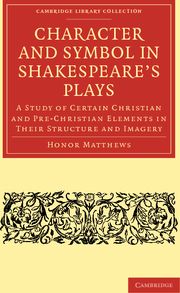 Character and Symbol in Shakespeare's Plays
Character and Symbol in Shakespeare's Plays Book contents
Chapter IV - Justice, Mercy and False-seeming
Published online by Cambridge University Press: 07 September 2010
Summary
After Measure for Measure, although a trial may still appear as a muted theme in situation, as when Lear arraigns Goneril and Regan, or in imagery, as when Macbeth imagines even-handed justice commending his poisoned chalice to his own lips, Shakespeare puts aside the simple symbolism so effective in the long development of the Débat du Paradis and illuminates man's concern with justice and mercy by other means. It appears to be significant that he abandons the structure so strongly associated with the religious drama at the very moment when his own plays become most numinous in quality. The Christian tradition in which his thought is rooted is centred in the polarity between fear and love. These are the values that the ‘machiavel’, Richard, explicitly denies:
I, that have neither pity, love, nor fear,
3 Henry VI, v, vi, 68and which Shakespeare never abandons. The necessary fear of evil and of its just punishment is as genuine in The Tempest as in Richard III and only less powerful than the love which finally transcends it. Nevertheless, the melting of the old imagery in the white heat of the later tragedies is no coincidence, for it can be shown that Shakespeare finally indicates a resolution of the paradox of Justice and Mercy in non-dogmatic terms. Before this is discussed, however, it is necessary to consider the subordinate but relevant theme of false-seeming and its power to deceive and destroy.
In the Ludus Coventriae, Misericordia, in her plea for man, said to her sister Justicia:
Ye must consider the frailness of mankind;
Learn and ye list, this is God's love;
Parliament of Heaven, 11. 110–11- Type
- Chapter
- Information
- Character and Symbol in Shakespeare's PlaysA Study of Certain Christian and Pre-Christian Elements in Their Structure and Imagery, pp. 119 - 138Publisher: Cambridge University PressPrint publication year: 2009First published in: 1962


